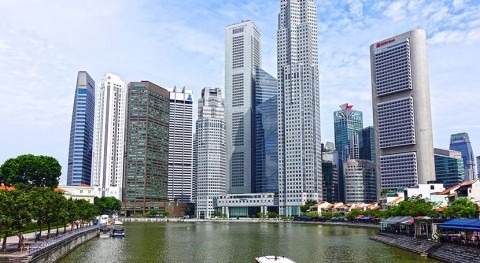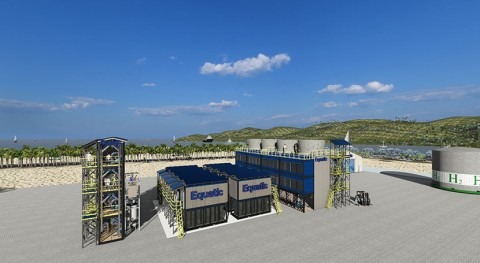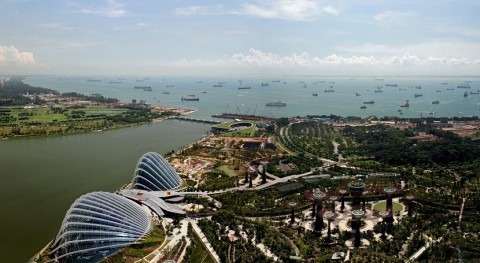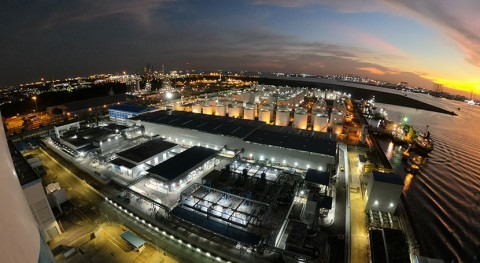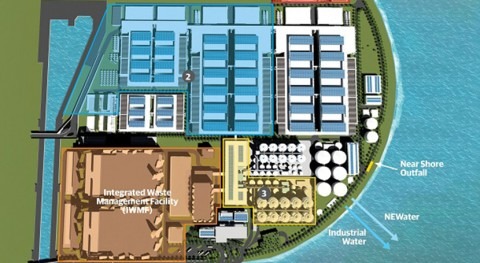Singapore's National Water Agency PUB has begun work on a state-of-the-art modelling system that is capable of simulating and evaluating both inland and coastal flood risks in tandem. This Coastal-Inland Flood Model will enable PUB to better assess the impact of climate change on Singapore's coastal areas. A consortium led by the National University of Singapore (NUS), with water management solutions provider Hydroinformatics Institute (H2i) as a partner, has been appointed to develop the model to support PUB's coastal protection efforts.
The purpose-built model will be developed based on Singapore's densely built-up and urbanised environment, and will enable holistic flood risk assessment by estimating the combined effects of extreme sea levels and inland floods caused by intense rainfall. It will comprise two independent models – a coastal model and an inland model – that can run separately or together to carry out flood risk analysis for different scenarios.
The model will aid PUB in the planning of coastal adaptation measures, to evaluate the effectiveness of proposed coastal protection infrastructure, as well as for operations management. Development will take about four years and be continually updated and improved along with new climate data and developments in climate science. In the near term, the model will also be able to support the upcoming site-specific studies, starting with the City-East Coast and Jurong island.
The coastal model will be equipped to simulate potential changes in nearshore waves and storm surge activities within the region under different climate change scenarios, while the inland model will be capable of simulating urban flooding caused by different sources, including heavy rainfall, and their interactions with sea levels. Advanced modelling techniques will be used to enhance the accuracy and speed in simulating rainfall-induced flows within Singapore's densely built-up water catchments.
PUB officers will work closely with the team from NUS and H2i during the entire project duration, to share their experience with existing modelling systems. This will also allow PUB to build new expertise in-house to develop, test and validate coastal protection technologies and concepts. When completed, PUB will be equipped to operate the model and make future enhancements to it when needed.
The project team will be led by Philip Liu, Distinguished Professor in the NUS Department of Civil and Environmental Engineering. Professor Liu, who is internationally recognised for his work on coastal engineering and wave modelling, has been instrumental in developing tsunami and coastal disaster resilience technology in Taiwan and the South China Sea region. H2i will bring to the table its rich expertise in hydrological and inland flow modelling and model development, having worked with PUB previously on its rainfall monitoring and predicting system, which uses X-band radar technology.
Ms Hazel Khoo, Director of PUB's Coastal Protection Department, said, “As a small coastal city with many low-lying areas, Singapore is particularly susceptible to rising sea levels. Coupled with the upward trend of average annual rainfall and frequency of heavy rainfall that we have observed in recent years, the development of this model is timely as we embark on the monumental task of building coastal defences for Singapore. Through this project, we aim to enhance capabilities and deepen our expertise in modelling to support coastal protection efforts from now and into the future. Given the uncertainties in climate science, protecting our coastlines will always be a work-in-progress, but we aim to stay ahead of the curve. We are pleased to have both NUS and H2i on board and look forward to working with them on this important project."
Professor Liu added, “NUS is excited to be leading this consortium. I am confident that the synergistic pool of talent and resources from NUS, H2i and PUB will catalyse a collaborative advancement of Singapore's efforts to bolster coastal protection. In anticipating continued climate changes, the development of a Coastal-Inland Flood Model is timely and will help to safeguard both our coastlines and our collective future against severe weather and rising sea levels."
H2i's Director, Martin Lechner, said, “H2i has, through our various projects, developed a depth and breadth of understanding of the impact that climate change could have on both lives and livelihoods in Singapore. We have already deployed our capabilities in areas like coastal monitoring and modelling and flood-risk management, and the development of the Coastal-Inland Flood Model builds on this. The combined expertise of our team, which includes renowned industry leaders like hydraulics specialist Professor Guus Stelling, will mean faster, more accurate and more visual water management insights. This will allow Singapore to better plan for climate change, and secure its own future."




